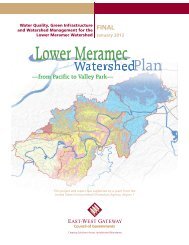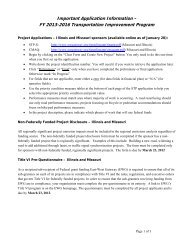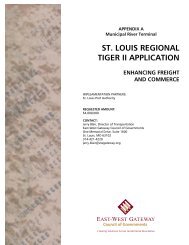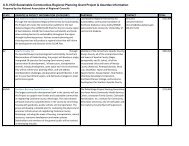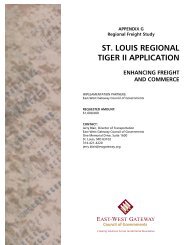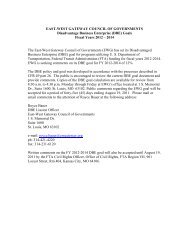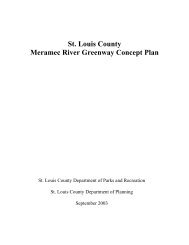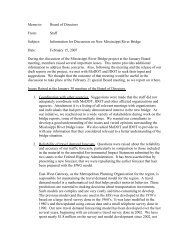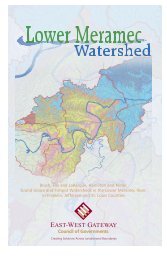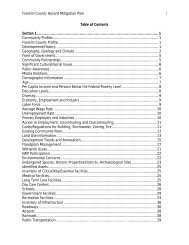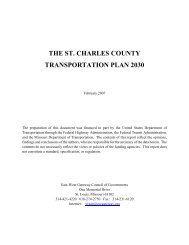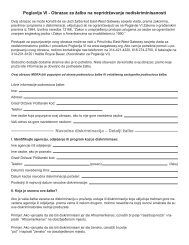Jefferson County - East-West Gateway Coordinating Council
Jefferson County - East-West Gateway Coordinating Council
Jefferson County - East-West Gateway Coordinating Council
Create successful ePaper yourself
Turn your PDF publications into a flip-book with our unique Google optimized e-Paper software.
A Regional Overview All-Hazard Mitigation Plan 35<br />
Recommendation<br />
In 1996, MDNR/DGLS, Dick Gaffney prepared a Flood Analysis Report, based on four<br />
documents: The Report and Recommendations of the Governor’s Task Force on Flood Plain<br />
Management on behalf of Governor Carnahan, July, 1994; The Floods of ’93, State of<br />
Missouri -- The Federal Interagency Hazard Mitigation Team, Report For the Three<br />
Presidential Disaster Declarations in Missouri, April, 1994, as set up by FEMA under 1988<br />
Stafford Act; Sharing the Challenge: Floodplain Management into 21 st Century -- The<br />
Report of the Interagency Floodplain Management Review Committee to the<br />
Administration (Whitehouse) Floodplain Management Task Force; A Blueprint for Change,<br />
June, 1994 and National Flood Policy in Review-1994 by Association of State Floodplain<br />
Managers (ASFPM). Recommendations made by these documents are summarized below:<br />
All four post-flood reports recommend that the state should take an active role in<br />
flood plain management, determine state flood plain management, determine state<br />
flood plain management policy and implement it.<br />
The reports generally agreed that the hydrology of the Missouri and the Mississippi<br />
rivers should be reviewed, with the possible result that base flood elevations should<br />
be recalculated and new flood maps issued.<br />
The encouragement of participation in the National Flood Insurance Program, both<br />
by communities and individual property owners was stressed to the point that<br />
recommendations stated that post-flood disaster assistance to those not insured<br />
should be limited, reduced or withheld. The problems of mortgage lenders and<br />
borrowers were addressed and escrow of premiums for flood insurance was<br />
emphasized.<br />
Maintaining flood insurance purchase requirements behind levee protection works<br />
was recommended. Further, it was recommended that the state develop a<br />
definition of market value to assure compliance with flood insurance regulations,<br />
dealing with substantial damages.<br />
Levees, levee districts, levee protection systems, state levee permits, levee<br />
construction criteria, levee repairs and levee heights were addressed by the four<br />
reports as a result of the levee failures in the 1993 flooding. More state<br />
involvement in this topic was universally recommended, especially with regard to<br />
oversight and permits. These recommendations imply that it is critical with respect<br />
to property owners and their lives that the flood stages remain stable (does not<br />
fluctuate as a result of levees built upstream). The aggregate result will be to<br />
increase the flood danger by increasing the height and velocity of river flow during<br />
floods.<br />
Greater environmental sensitivity and increased state government involvement in<br />
flood plain matters was stressed in the post-flood reports. Public health and safety<br />
during flood events was also stressed, especially in regard to hazardous materials.<br />
Government agencies should inventory their property to determine their<br />
vulnerability to future flooding.<br />
Federal agencies should collaborate on an assessment of effectiveness of stream<br />
gauging network and flood forecasting/models.



